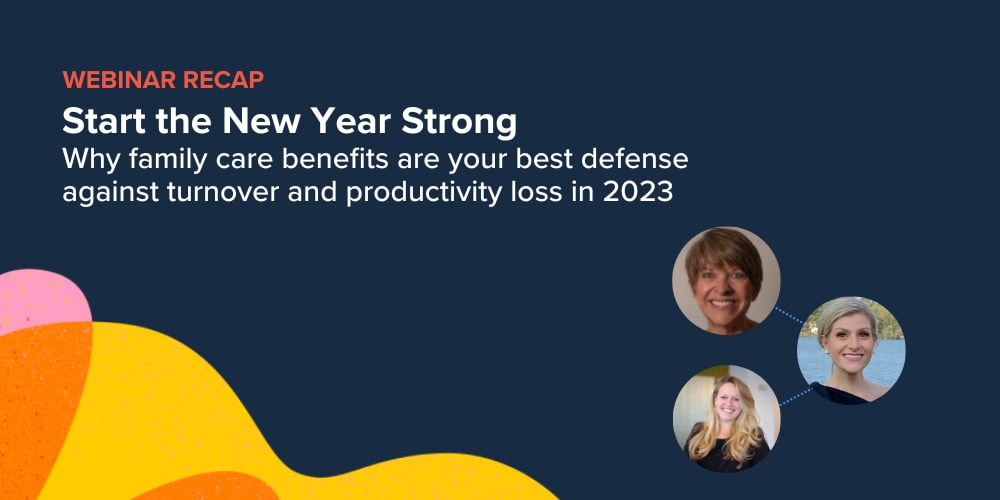Working moms have been doing the heavy lifting when it comes to child care for years, and then came the pandemic. During the first few months of the 2020 lockdown, approximately 3.5 million women lost their jobs, took paid (or unpaid) leave, or left the workforce.
Now that remote work has become the new normal for millions of people we wanted to find out if employers are really embracing the flexibility of remote work, and what the impact has been on working caregivers.
Care.com partnered with Mother Honestly to poll 1,000 employee caregivers and 500 business decision makers, including:
- C-suite executives
- HR or other senior management leaders
- Lead benefits decision makers
In a nutshell, remote work is a part of the current, and future, workforce. Employers who get that will win in the war for talent. Those who try to force workers back into the office will lose.
Flexibility rules when it comes to where employees work
Now that employees have had a taste of the convenience and flexibility of working from home, most are not eager to return to the grind of a daily commute. When asked about the type of work arrangement they most desired:
- 53% of employees said they prefer having a remote option
- 44% prefer hybrid
- 43% want to be in the office full time
Managers are clearly taking notes, because when asked about their remote hiring practices:
- 39% of managers said they are currently hiring fully remote employees
- 16% have previously done so
- 32% are considering it
Fifty-six percent of managers say turnover has increased since the start of the pandemic, which tracks with the 51% of employees who say they have changed jobs. In fact, 22% have done so multiple times. While people quit for a variety of reasons, a desire for greater flexibility is certainly a key reason today.
Worker preferences are not always aligned with those of their bosses, but in this case, managers seem to realize that they need to be more flexible if they want to keep the employees they have, and the ability to hire new ones.
Work location flexibility leads to happier employees
When asked to evaluate their happiness levels with full-time, in-office work versus a hybrid arrangement, 56% of employees said they are happiest working in a hybrid arrangement, versus 22% who find their bliss being in an office full time.
Managers and employees are both on the same page when it comes to the impact that remote work has on quality of life. Seventy-six percent of caregivers say remote work improves their overall quality of life, and 77% of managers agree.
One obvious impact on remote and/or hybrid workers’ lives is that they’re spending less time commuting to an office. Eighty-eight percent of employees say they save more than 30 minutes a day when they skip the commute, and 67% save an hour or more. Working caregivers are investing those time savings in more fulfilling and meaningful ways, like:
- Spending more time with their kids (73%)
- Doing household chores (71%)
- Spending more time with a partner/spouse (70%)
- Leisure activities (67%)
- Hobbies (65%)
- Exercise (63%)
- Sleeping (63%)
- Prepping for the day ahead (59%)
- Socializing with friends (56%)
- Professional development (55%)
In addition, two-thirds of employees who are caregivers for senior loved ones report spending more time with them now that they don’t have to commute, and 60% say that working remotely helps them to keep better tabs on their senior loved one’s health and well-being.
Remote work leads to higher productivity
One of the key metrics businesses look at when evaluating any change in work processes is productivity. Remote work has the edge there too. Of those surveyed, 55% of employees say they are more productive working remotely, and an even higher percentage of managers, 58%, agree.
Caregivers and managers agree that employees are also working more hours when they work from home. Forty-six percent of employees say they work longer hours when they work remotely, and 50% of managers agree.
Some likely contributing factors to this boost in productivity include the fact that workers might use commuting time savings to get an early jump on the day. Another possibility is that happier workers are less burned out workers, which leads to increased productivity. It could also be that the flexibility of being able to work from home allows them to intersperse family and household responsibilities with their work duties. Meaning, they may be working longer hours, but they are also taking breaks to tend to their, and their families’, needs.
Working caregivers need caregiving benefits
The ability to work remotely is helping employees juggle their work/life demands, but it’s still not enough. The government has failed at enacting more family-friendly policies. The Inflation Reduction Act was originally on track to provide universal pre-kindergarten, paid family and sick leave, lower child care costs, and the enhanced child tax credit—but those provisions were all cut before the bill passed. Not only that, more than 16,000 child care centers have closed since the start of the pandemic, and 400,000 workers have quit their jobs at long-term care facilities. All of this is causing a caregiver crisis.
As a result, many employees are looking to their employers for help with caregiving needs. Fifty-five percent of managers say they are receiving more requests for child care support benefits, and 49% are reporting the same when it comes to senior care.
Employers report that they are stepping up to meet these needs. More than half (51%) of managers say their company has changed their care benefit offerings, and 32% have changed the stipends they offer for care.
It may cost companies more to offer care benefits, but it makes good business sense in the current business climate. Employees say it’s making a difference, with 83% of employees with child care responsibilities reporting that their employer’s support level is strong, which is echoed by 82% of managers. In addition, 75% of employees who care for seniors report strong support from their company, which 76% of managers agree with.
Business leaders who don’t add—or decide to cut—care benefits such as child care benefits and paid parental leave, will likely find themselves with higher turnover, and fewer applicants eager to apply for openings. Plus, offering child care benefits has been shown to boost companies retention and recruitment rates, increase productivity and reduce burnout.
When it comes to meeting the needs of the modern workforce the solutions are clear: offer greater flexibility, including remote work, and support working caregivers with caregiving benefits.
Download The Modern Workplace Report to learn more about the future of the modern workplace, including how remote work is leveling the playing field between women and men, and what employers need to do to make sure they’re not favoring in-office versus remote workers.






